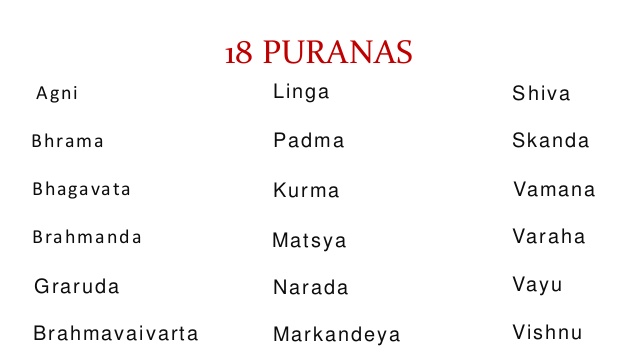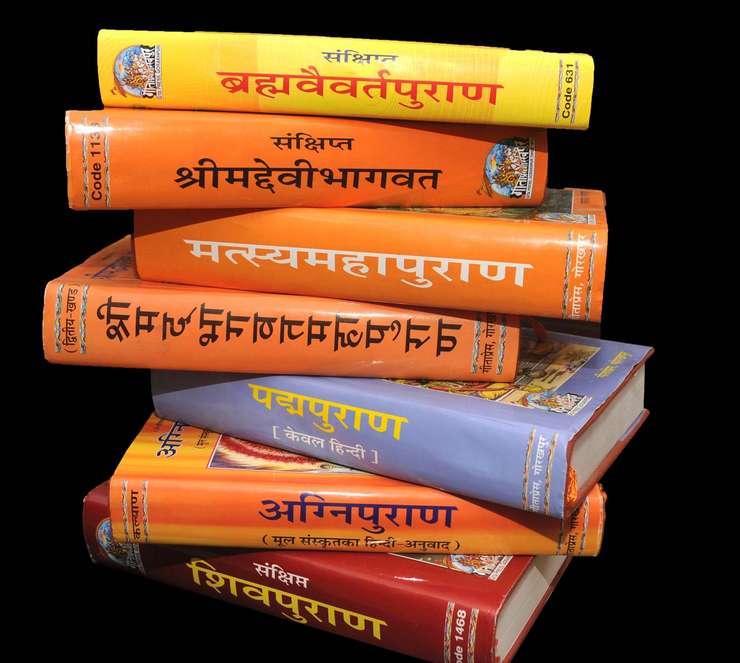The 18 Important Puranas of Hinduism
In Second Part of series “Understanding Puranas”, we present a premise and context of all the 18 Puranas as an introduction ( Puranas of Hinduism ). This article throws light on what is the subject of each Purana and what it deals with. With this brief introduction to 18 Puranas, we are all set to look into, in-depth, into each Purana.
Puranas are the stories of Kings and Gods. Passed on as oral tradition, later became written text. Over the period, the Puranas have taken different shapes. But after a certain point the main text now remains the same. The Puranas have the spirit of the Vedas and written to popularize the thoughts contained in the Vedas. They were meant, not for the scholars, but for the ordinary people who could hardly comprehend the high philosophy of the Vedas (Puranas of Hinduism).

The aim of the Puranas is to impress upon the minds of the masses the teachings of the Vedas and to generate in them devotion to God, through concrete examples, myths, stories, legends, lives of saints, kings and great men, allegories, and chronicles of great historical events. Ancient sages used these images to illustrate the eternal principles of the belief system that came to be known as Hinduism -Puranas of Hinduism.
The Puranas helped the priests to hold religious discourses in temples and on banks of holy rivers, and people loved to hear these stories. These texts are not only replete with information of all kinds but also very interesting to read. In this sense, the Puranas play a pivotal role in Hindu theology and cosmogony.

Most popular among the Puranas are the Srimad Bhagavata Purana and the Vishnu Purana. In popularity, they follow the same order. A portion of the Markandeya Purana is well known to all Hindus as Chandi, or Devimahatmya. Worship of God as the Divine Mother is its theme. Chandi is read widely by the Hindus on sacred days and Navaratri days – Puranas of Hinduism.
18 Puranas and Importantanse
1. Agni Purana: Includes geography of Mithila (Bihar and neighboring states), cultural history, politics, education system, iconography, taxation theories, organization of army, theories on proper causes for war, diplomacy, local laws, building public projects, water distribution methods, trees and plants, medicine, Vastu Shastra (architecture), gemology, grammar, metrics, poetry, food, rituals and numerous other topics.
2. Bhagavat Purana: The most studied and popular of the Puranas, telling of Vishnu’s Avatars, and of Vaishnavism. It contains controversial genealogical details of various dynasties. Numerous inconsistent versions of this text and historical manuscripts exist, in many Indian languages. Influential and elaborated during Bhakti movement.
3. Brahma Purana: Most popular among the Puranas are the Srimad Bhagavata Purana and the Vishnu Purana. In popularity, they follow the same order. A portion of the Markandeya Purana is well known to all Hindus as Chandi, or Devimahatmya. Worship of God as the Divine Mother is its theme. Chandi is read widely by the Hindus on sacred days and Navaratri days.
4. Brahmanda Purana: One of the earliest composed Puranas, it contains a controversial genealogical details of various dynasties. Includes Lalita Sahasranamam, law codes, system of governance, administration, diplomacy, trade, ethics. Old manuscripts of Brahmanda Purana have been found in the Hindu literature collections of Bali, Indonesia.
5. Brahmavaivarta Purana: It is related by Savarni to Narada, and centres around the greatness of Krishna and Radha. In this, the story of Brahma-varaha is repeatedly told. Notable for asserting that Krishna is the supreme reality and the gods Vishnu, Shiva, Brahma are incarnations of him. Mentions geography and rivers such as Ganga to Kaveri.
6. Garuda Purana: Primarily about Vishnu, but praises all gods. Describes how Vishnu, Shiva and Brahma collaborate. Many chapters are a dialogue between Vishnu and the bird-vehicle Garuda. Cosmology, Describes cosmology, relationship between gods. The final chapters discuss how to practice Yoga (Samkhya and Advaita types), personal development and the benefits of self-knowledge.
7. Kurma Purana: This is a combination of Vishnu and Shiva related legends, mythology, Tirtha (pilgrimage) and theology.
8. Linga Puran: Talks about Lingam, symbol of Shiva, and origin of the universe. It also contains many stories of Lingam, one of which entails how Agni Lingam solved a dispute between Vishnu and Brahma.
9. Markandeya Purana: Explains Vindhya Range and western India. Probably composed in the valleys of Narmada and Tapti rivers, in Maharashtra and Gujarat. Named after sage Markandeya, a student of Brahma. Contains chapters on dharma and on Hindu epic Mahabharata. The Purana includes Devi Mahatmyam of Shaktism.
10. Matsya Purana: Tells the story of Matsya, the first of ten major Avatars of Vishnu. Likely composed in west India, by people aware of geographical details of the Narmada river. Includes legends about Brahma and Saraswati. It also contains a controversial genealogical details of various dynasties.
11. Narada Purana: Explains the four Vedas and the six Vedangas. Dedicates one chapter each, from Chapters 92 to 109, to summarize the other 17 Maha Puranas and itself. Lists major rivers of India and places of pilgrimage, and a short tour guide for each. Includes discussion of various philosophies, soteriology, planets, astronomy, myths and characteristics of major deities including Vishnu, Shiva, Devi, Krishna, Rama, Lakshmi and others.
12. Padma Purana: The north Indian manuscripts of Padma Purana are very different from south Indian versions, and the various recensions in both groups in different languages (Devanagari and Bengali, for example) show major inconsistencies. Like the Skanda Purana, it is a detailed treatise on travel and pilgrimage centers in India.
13. Shiva Purana: Tells us about Shiva, and stories about him. It primarily centers around the Hindu god Shiva and goddess Parvati, but references and reveres all gods. The Shiva Purana contains chapters with Shiva-centered cosmology, mythology, relationship between gods, ethics, Yoga, Tirtha (pilgrimage) sites, bhakti, rivers and geography, and other topics.
14. Skanda Purana: Describes the birth of Skanda (or Karthikeya), son of Shiva. The longest Purana, it is an extraordinarily meticulous pilgrimage guide, containing geographical locations of pilgrimage centers in India, with related legends, parables, hymns and stories. Many untraced quotes are attributed to this text.
15. Vamana Purana: The text is named after one of the incarnations of Vishnu and probably was a Vaishnava text in its origin. However, the modern surviving manuscripts of Vamana Purana are more strongly centered on Shiva, while containing chapters that revere VIshnu and other Hindu gods and goddesses. It is considered a Shaiva text. Further, the text hardly has the character of a Purana, and is predominantly a collection of Mahatmyas (travel guides) to many Shiva-related places in India with legends and mythology woven in.
16. Varaha Purana: Basically a Vishnu-related worship manual, with large Mahatmya sections or travel guide to Mathura and Nepal. Presentation focuses on Varaha as incarnation of Narayana, but rarely uses the terms Krishna or Vasudeva. Many illustrations also involve Shiva and Durga.
17. Vayu Purana: Is considered as the oldest of all Maha Puranas. Some medieval Indian texts call it Vayaviya Purana. Mentioned and studied by Al Biruni, the 11th century Persian visitor to India. Praises Shiva. Discusses rituals, family life, and life stages of a human being.
18. Vishnu Purana: Better preserved after the 17th century, but exists in inconsistent versions, more ancient pre-15th century versions are very different from modern versions, with some versions discussing Buddhism and Jainism. Some chapters likely composed in Kashmir and Punjab region of South Asia. A Vaishnavism text, focussed on Vishnu.









